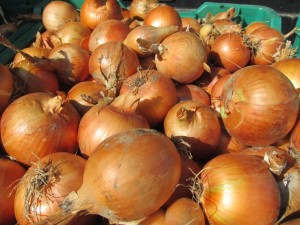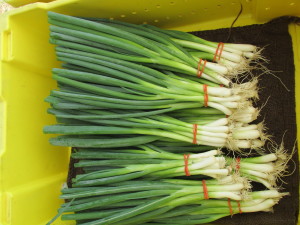Availability, Nutrition, and Recipe Suggestions
In Season: Scallions (aka Green Onions) – June through the fall
Onions – July through the fall
Fresh Shallots – late August into the fall
Storage: Scallions are best stored in the fridge in a plastic bag, they will keep a week or longer. “Fresh” Onions haven’t been cured and therefore won’t keep more than a few weeks; they are best stored out of the sun on the counter. Dry or Storage Onions, available starting in September, will keep for months if properly stored. Dry onions should be stored in a cool, dry, and well ventilated place (not in a plastic bag).
Preservation: Onions may be frozen, but keep in mind their flavor and scent can travel if not properly sealed. We recommend freezing carmelized onions, which take up less space and add sweetness to a recipe. Pickled Red Onions are a delicious condiment, though they are best stored for just a few weeks [The Kitchen].
Production Notes: We aim to produce scallions from late Spring into November. Our supply is typically steady throughout the season; though the size of the scallions will vary depending on where in the harvest cycle we are… when we first start picking a new plot the scallions will be small and delicate, as we make our way through the planting they will size up considerably… still delicious!
Onions are available fresh from the fields starting in July, fresh onions will have a higher water content and will include some of our milder varieties. From September onward our onions come from short term storage in our barn.
Varieties: Among the notable varieties… Purplette Mini-Onions kick off the season in early July. Red Tropea, Italian Torpedo Onions, Zoey, and Sierra Blanca are all early season fresh onions which are suitable for raw flavors. The Red Cabernet Onions are one of summer’s great joys and are not to be missed in August. Note: we don’t grow traditional sweet onions (Vidalia types); sweet onions are grown on soils with low sulfur levels – our fields at Brix Bounty are amended to bring out the full nutritional potential in our crops and this includes an emphasis on sulfur.
Nutrition: Onions are a good source of vitamin C and manganese [WHFoods.com].
Deep Nutrition: Onions are noted for their high polyphenol content, they are an especially good source of quercetin [Dr. Mercola]. Onions are often included in a list of healthy vegetables to consumer when “fighting” cancer. The quercetin content is highest on the outer layers of onions, so peel carefully…
Deep Science: Like leeks, onions are in the Allium Family… Let alliums “rest” after chopping – see how to ensure allicin is abundant when you consume alliums including Leeks. And for more science, here’s a quick NY Times article “The Chemical Weapons of Onions and Garlic”
Preparation: Scallions should be rinsed gently to remove any field dirt. A quick onion peeling tip from The Daily Meal, including some mesmerizing dicing techniques; onions are best chopped with a sharp chef’s knive. Let the onions rest if you are aiming for allicin (see above – deep science). It’s suggested to avoid high heat when sauteeing onions to avoid bitterness… better to use low or medium heat.
Name of Crop Recipe Suggestions:
- One of my favorite breakfast flavors of summertime is sliced onion and fresh tomato on a cream cheese bagel. It’s worth the trip to Route 6 in Dartmouth to get fresh bagels from New York Bagel… though we prefer the fine flavor and quality of Organic Valley Cream Cheese made with milk from pasture-raised cows… add a bit of salt & pepper and you are close to heaven.
- French Onion Soup, a sure fire hit for the late fall/winter [Food Network]
- Mandolin Sliced Onion Salad [SBS Food Au]
- “The Best Way to Tame Onions in Salad” – suggests soaking onions in dressing for better salads [Kitchn].
- How to Carmelized Onions, a kitchen tutorial [bon appetit]
- Deborah Madison’s Fragrant Onion Tart ! [NY Times]
- Onion Tart Recipe w/puff pastry… [Food Republic]
Yum.

